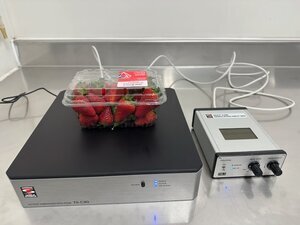
College of Engineering Unit:
In collaboration with the Department of Food Sciences, our task was to design and manufacture a mechanism to simulate the transportation of fruit (e.g., strawberries) in a tractor-trailer. This mechanism includes a vibration shaker table, a digital signal generator, and signal amplifier. A sinusoidal signal controlled by the signal generator and the amplifier will be fed to the shaker. Based on the frequency components of the measured vibrations in a truck when transporting strawberries locally, a set of sinusoidal signals will be used to accurately simulate the frequencies found each at an acceleration level of 0.2 g (1 g = 9.8 m/s2). A piezoelectric accelerometer inside the testing platform and a National Instrument data acquisition system will be used to monitor the vibration levels during the test. Each box of fruit samples will be subjected to vibrations for 2 hours at room temperature. The stationary (i.e., non-vibrated) samples will also be kept in the same conditions for 2 hours. The vibrated and non-vibrated strawberries will both be stored at 4 degrees Celsius after the vibration tests. Accurately replicating fruit transportation damage is the first step to creating robust packaging that minimizes fruit damage, and subsequently waste.